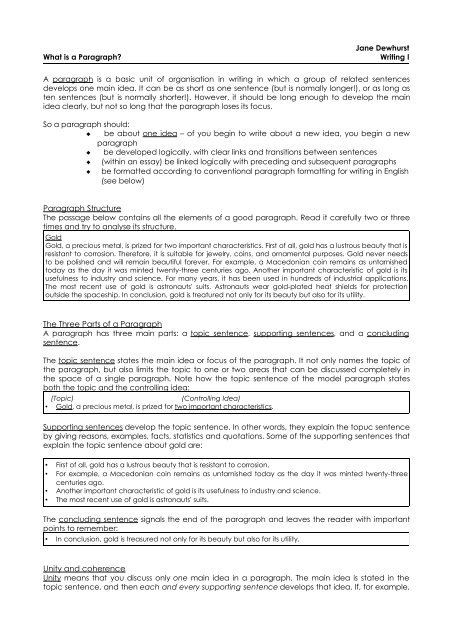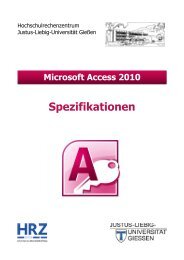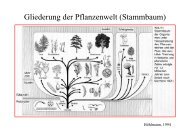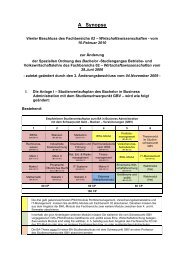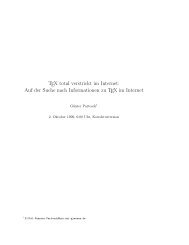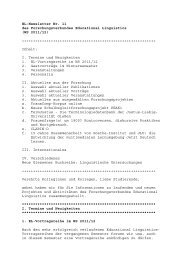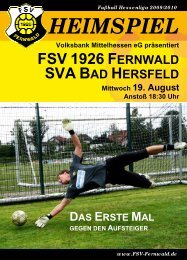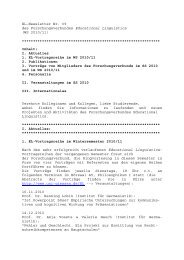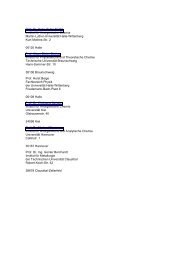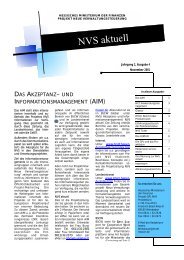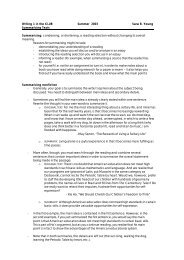Jane Dewhurst What is a Paragraph? Writing I A paragraph is a ...
Jane Dewhurst What is a Paragraph? Writing I A paragraph is a ...
Jane Dewhurst What is a Paragraph? Writing I A paragraph is a ...
Create successful ePaper yourself
Turn your PDF publications into a flip-book with our unique Google optimized e-Paper software.
<strong>Jane</strong> <strong>Dewhurst</strong><br />
<strong>What</strong> <strong>is</strong> a <strong>Paragraph</strong>? <strong>Writing</strong> I<br />
A <strong>paragraph</strong> <strong>is</strong> a basic unit of organ<strong>is</strong>ation in writing in which a group of related sentences<br />
develops one main idea. It can be as short as one sentence (but <strong>is</strong> normally longer!), or as long as<br />
ten sentences (but <strong>is</strong> normally shorter!). However, it should be long enough to develop the main<br />
idea clearly, but not so long that the <strong>paragraph</strong> loses its focus.<br />
So a <strong>paragraph</strong> should:<br />
be about one idea – of you begin to write about a new idea, you begin a new<br />
<strong>paragraph</strong><br />
be developed logically, with clear links and transitions between sentences<br />
(within an essay) be linked logically with preceding and subsequent <strong>paragraph</strong>s<br />
be formatted according to conventional <strong>paragraph</strong> formatting for writing in Engl<strong>is</strong>h<br />
(see below)<br />
<strong>Paragraph</strong> Structure<br />
The passage below contains all the elements of a good <strong>paragraph</strong>. Read it carefully two or three<br />
times and try to analyse its structure.<br />
Gold<br />
Gold, a precious metal, <strong>is</strong> prized for two important character<strong>is</strong>tics. First of all, gold has a lustrous beauty that <strong>is</strong><br />
res<strong>is</strong>tant to corrosion. Therefore, it <strong>is</strong> suitable for jewelry, coins, and ornamental purposes. Gold never needs<br />
to be pol<strong>is</strong>hed and will remain beautiful forever. For example, a Macedonian coin remains as untarn<strong>is</strong>hed<br />
today as the day it was minted twenty-three centuries ago. Another important character<strong>is</strong>tic of gold <strong>is</strong> its<br />
usefulness to industry and science. For many years, it has been used in hundreds of industrial applications.<br />
The most recent use of gold <strong>is</strong> astronauts' suits. Astronauts wear gold-plated heat shields for protection<br />
outside the spaceship. In conclusion, gold <strong>is</strong> treatured not only for its beauty but also for its utility.<br />
The Three Parts of a <strong>Paragraph</strong><br />
A <strong>paragraph</strong> has three main parts: a topic sentence, supporting sentences, and a concluding<br />
sentence.<br />
The topic sentence states the main idea or focus of the <strong>paragraph</strong>. It not only names the topic of<br />
the <strong>paragraph</strong>, but also limits the topic to one or two areas that can be d<strong>is</strong>cussed completely in<br />
the space of a single <strong>paragraph</strong>. Note how the topic sentence of the model <strong>paragraph</strong> states<br />
both the topic and the controlling idea:<br />
(Topic) (Controlling Idea)<br />
• Gold,<br />
a precious metal, <strong>is</strong> prized for two important character<strong>is</strong>tics.<br />
Supporting sentences develop the topic sentence. In other words, they explain the topuc sentence<br />
by giving reasons, examples, facts, stat<strong>is</strong>tics and quotations. Some of the supporting sentences that<br />
explain the topic sentence about gold are:<br />
• First of all, gold has a lustrous beauty that <strong>is</strong> res<strong>is</strong>tant to corrosion.<br />
• For example, a Macedonian coin remains as untarn<strong>is</strong>hed today as the day it was minted twenty-three<br />
centuries ago.<br />
• Another important character<strong>is</strong>tic of gold <strong>is</strong> its usefulness to industry and science.<br />
• The most recent use of gold <strong>is</strong> astronauts' suits.<br />
The concluding sentence signals the end of the <strong>paragraph</strong> and leaves the reader with important<br />
points to remember:<br />
• In conclusion, gold <strong>is</strong> treasured not only for its beauty but also for its utility.<br />
Unity and coherence<br />
Unity means that you d<strong>is</strong>cuss only one main idea in a <strong>paragraph</strong>. The main idea <strong>is</strong> stated in the<br />
topic sentence, and then each and every supporting sentence develops that idea. If, for example,
<strong>Jane</strong> <strong>Dewhurst</strong><br />
<strong>What</strong> <strong>is</strong> a <strong>Paragraph</strong>? <strong>Writing</strong> I<br />
you announce in your topic sentence that you are going to d<strong>is</strong>cuss two important character<strong>is</strong>tics of<br />
gold, d<strong>is</strong>cuss only those. Do not d<strong>is</strong>cuss anything else such as the price of gold, the h<strong>is</strong>tory of gold,<br />
or gold mining.<br />
Coherence means that your <strong>paragraph</strong> <strong>is</strong> easy to read and understand because 1) your supporting<br />
sentences are in some kind of logical order and 2) your ideas are connected by the usse of<br />
appropriate connecting words and transition signals. For example, in the <strong>paragraph</strong> about gold,<br />
there are two supporting ideas: gold <strong>is</strong> beautiful and gold <strong>is</strong> useful. Each of these supporting ideas <strong>is</strong><br />
d<strong>is</strong>cussed, one after the other, and an example <strong>is</strong> given for each one. Th<strong>is</strong> <strong>is</strong> one kind of logical<br />
order. Furthermore, the relationship between the ideas <strong>is</strong> clearly shown by using appropriate<br />
transition words and phrases such as "first of all", "the second important character<strong>is</strong>tic", "for<br />
example" and "in conclusion".<br />
From: Alice Oshima and Ann Hogue, <strong>Writing</strong> Academic Engl<strong>is</strong>h, 2 nd Edition (New York: Longman, 1991), pp.16f.<br />
<strong>Paragraph</strong> Formatting<br />
One of the main differences between <strong>paragraph</strong>s in Engl<strong>is</strong>h and German writing <strong>is</strong> that the first line<br />
of an Engl<strong>is</strong>h <strong>paragraph</strong> <strong>is</strong> indented (eingerückt). In Engl<strong>is</strong>h academic writing, therefore, a new<br />
<strong>paragraph</strong> should begin like th<strong>is</strong>:<br />
The first sentence of an Engl<strong>is</strong>h <strong>paragraph</strong> <strong>is</strong> preceded by a TAB space, or a gap of approximately one<br />
centimetre. <strong>Paragraph</strong>s are not separated by a line space in Engl<strong>is</strong>h, your new <strong>paragraph</strong> can begin on the<br />
line directly below the old, but it must be indented (eingerückt).<br />
So your new <strong>paragraph</strong> would begin like th<strong>is</strong>! ...........


